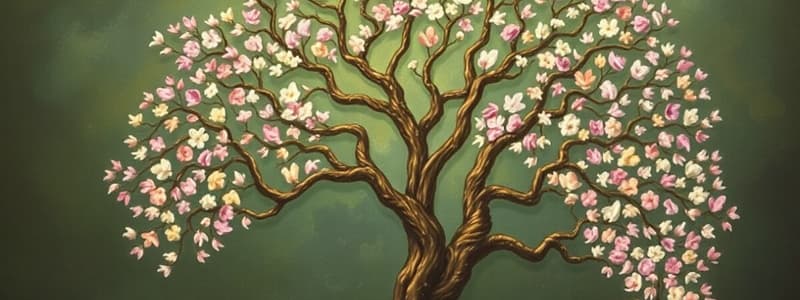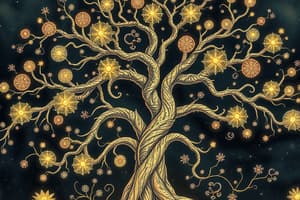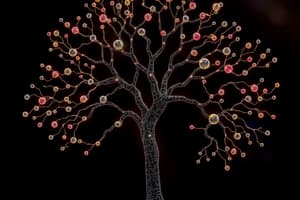Podcast
Questions and Answers
What was the predominant view of the world from 500 to 1500 AD?
What was the predominant view of the world from 500 to 1500 AD?
- Tree of Life
- Scala Naturae (correct)
- Theory of Evolution
- Natural Selection
What classification system did Carl Linnaeus propose?
What classification system did Carl Linnaeus propose?
- Systema Naturae (correct)
- Cladistics
- Natural Selection
- Phylogenetics
What key concept did Charles Darwin contribute to our understanding of evolution?
What key concept did Charles Darwin contribute to our understanding of evolution?
- Natural Theology
- Allele Frequency Change (correct)
- Genetic Drift
- Fossil Evidence
What was Edwin Hitchcock's contribution to the classification of life?
What was Edwin Hitchcock's contribution to the classification of life?
What is the significance of using both living and fossil evidence in constructing the tree of life?
What is the significance of using both living and fossil evidence in constructing the tree of life?
What historical perspective still influences some views on evolution today?
What historical perspective still influences some views on evolution today?
How did baleen whales evolve according to morphological evidence?
How did baleen whales evolve according to morphological evidence?
What process did Charles Darwin NOT know about when he published his work?
What process did Charles Darwin NOT know about when he published his work?
What process in humans leads to the separation of fingers during development?
What process in humans leads to the separation of fingers during development?
Which type of whales are considered filter feeders?
Which type of whales are considered filter feeders?
What term describes a derived characteristic shared by an evolutionary group, as seen in baleen and toothed whales?
What term describes a derived characteristic shared by an evolutionary group, as seen in baleen and toothed whales?
Which mammalian features are considered apomorphies?
Which mammalian features are considered apomorphies?
What adaptation do ancient whales possess for hearing in water?
What adaptation do ancient whales possess for hearing in water?
How do whales and humans share similarities in their limb structure?
How do whales and humans share similarities in their limb structure?
What evolutionary significance does Doryodon hold?
What evolutionary significance does Doryodon hold?
Which statement about the classification of whales is true?
Which statement about the classification of whales is true?
What is the purpose of phylogenetic trees?
What is the purpose of phylogenetic trees?
What is the role of apoptosis in human development?
What is the role of apoptosis in human development?
What is the medieval concept of "La scala naturae"?
What is the medieval concept of "La scala naturae"?
What shared trait is an example of synapomorphy among whales?
What shared trait is an example of synapomorphy among whales?
What process allows human fingers to separate during development?
What process allows human fingers to separate during development?
What is an example of apomorphy in mammals?
What is an example of apomorphy in mammals?
What defines evolution in modern terms?
What defines evolution in modern terms?
What molecular evidence is used to study mammalian evolution?
What molecular evidence is used to study mammalian evolution?
Flashcards
Baleen Whale
Baleen Whale
A type of whale that uses baleen plates to filter food from water.
Toothed Whale
Toothed Whale
A type of whale that uses teeth to catch and eat prey.
Synapomorphy
Synapomorphy
A shared derived trait that is present in two or more species due to their common ancestry, indicating their evolutionary relationship.
Apoptosis
Apoptosis
Signup and view all the flashcards
Apomorphy
Apomorphy
Signup and view all the flashcards
Homologous Trait
Homologous Trait
Signup and view all the flashcards
Phylogeny
Phylogeny
Signup and view all the flashcards
Evolutionary Biology
Evolutionary Biology
Signup and view all the flashcards
La scala naturae
La scala naturae
Signup and view all the flashcards
Linnaeus's Kingdom of animals
Linnaeus's Kingdom of animals
Signup and view all the flashcards
Medieval Thinking about Evolution
Medieval Thinking about Evolution
Signup and view all the flashcards
Evolution as a change in allele frequency
Evolution as a change in allele frequency
Signup and view all the flashcards
Lineage changes and diverges over time
Lineage changes and diverges over time
Signup and view all the flashcards
Tree of Life
Tree of Life
Signup and view all the flashcards
Morphological Evidence
Morphological Evidence
Signup and view all the flashcards
Methods for making a tree of life
Methods for making a tree of life
Signup and view all the flashcards
Study Notes
Lecture 2 - The Tree of Life - Part 1: Importance of the Tree of Life
- The Great Chain of Being (500-1500 AD) viewed life as a stairway, ascending from lower forms to higher forms.
- Higher beings in the hierarchy possessed all attributes of lower beings.
- The medieval view, La scala naturae, placed minerals at the bottom, then fire, plants, animals, humans, and God at the top.
- Linnaeus' Kingdom of Animals (1735) is a classification system.
Modern Linnaean View
- The Linnaean system classifies organisms into taxa: Kingdom, Phylum, Class, Order, Family, Genus, Species.
- Modern classification still shows influences of Medieval perspective, focusing on higher being, despite understanding of evolution.
Darwin and Diverging Lineages
- Darwin recognized extinction as a necessary aspect of evolution, needing many living species of the same genus to exist.
- He visualized species as branching lineages, although he lacked the mechanism of genetics.
- Darwin's sketch showed branching lineages, demonstrating relationships between organisms, and extinction of some forms.
Not Just Darwin: Edward Hitchcock
- Edward Hitchcock (1840) similarly envisioned branching lineages of extinct and living organisms, highlighting the concept of extinction.
- Hitchcock's work predated Darwin's publication, reflecting a similar understanding of evolution.
The Modern Synthesis of Genetics and Evolution
- Theodosius Dobzhansky (1937) redefined evolution as a change in allele frequency in a gene pool.
- Evolutionary biology has incorporated genetics and knowledge of mutations in creating a modern understanding.
- Evolutionary processes are explained in terms of genetic changes at the population level and understanding that genetics drives evolution.
Lineage Changes and Divergence Over Time
- Evidence from biology and fossil records show that lineages have changed and diverged over time.
- Various disciplines like behavioral ecology, morphology, and molecular biology help examine lineage changes over extended periods.
- Using morphological evidence from fossils to track lineages and observe evolutionary changes.
- The study of Whales used morphological data from fossils and extant whales to trace evolutionary changes.
Cetaceans: Whales, Dolphins, and Porpoises
- Cetaceans (whales, dolphins, porpoises) have two suborders: Mysticetes (baleen whales) and Odontocetes (toothed whales) and both emerged approximately 34 million years ago.
- Baleen whales filter feed using keratin-based baleen plates.
- Toothed whales are predators that use echolocation and have teeth.
Which Features Are Good for Classification?
- Homologous traits (similar traits due to shared ancestry) are useful for classification.
- Derived traits, or apomorphies, are features that are unique to a clade, offering valuable insights into evolutionary relationships.
How Can A Fin And A Hand Be Homologous?
- Similarities in developmental processes and underlying skeletal structures (e.g. bone patterns in the forelimbs of vertebrates) can highlight homologous traits of organisms in divergent branches.
Derived Traits Can Be Reduced or Lost
- The presence or absence of traits can give clues to the evolutionarily pathways and relationships of species.
- Certain traits present in ancestral organisms may be reduced or lost in later descendant species, for example, hind limbs in whales.
- Hidden traits can be re-discovered or used in combination with other data to determine evolutionary relationships.
Dorudon and Pakicetus
- Dorudon (40 million years old) and Pakicetus (50 million years old) are fossil whales demonstrating evolutionary progression from terrestrial ancestors.
Synapomorphies: Shared Derived Traits
- Synapomorphies are derived traits shared by two or more lineages.
- Using the traits of Pakicetus, whales and their mammalian relatives to highlight evolutionary relationships.
- A synapomorphy can be a trait acquired at a particular point in the evolution of a group.
Other Synapomorphies and Classification
- Shared traits are useful in classifying groups, establishing relationships and the order in which traits evolved.
- Groups identified from the ancestor and its descendants (cladistics), providing better understanding of the evolutionary pathways of organisms.
Autoapomorphies
- Autapomorphies are traits unique to a specific taxon and do not support broader groupings. Ex: platypus laying eggs (a trait that evolved after branching from other mammals).
- Using these traits for broader, general grouping of organisms isn't beneficial.
Studying That Suits You
Use AI to generate personalized quizzes and flashcards to suit your learning preferences.




